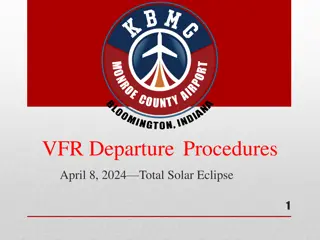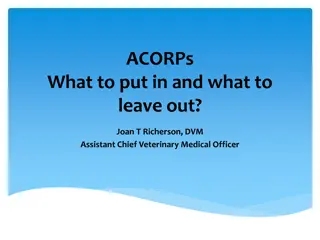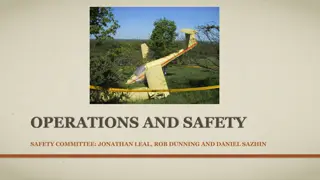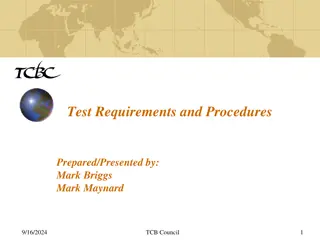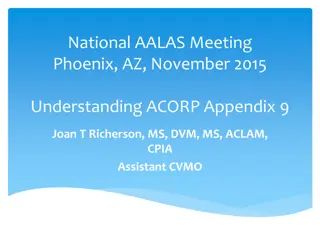IMC Club Meeting: VCOA, Departures, and Safety Procedures
Join the IMC Club Meeting focused on enhancing safety and proficiency through engaging discussions on topics like VCOA, diverse departures, and obstacle departure procedures. Learn about surveying airport guidelines, diverse departure definitions, and diverse procedure implementations. Explore concepts such as ODPs and how they impact aircraft departures. Stay informed and educated to improve your IFR clearance understandings and elevate your aviation knowledge.
Download Presentation

Please find below an Image/Link to download the presentation.
The content on the website is provided AS IS for your information and personal use only. It may not be sold, licensed, or shared on other websites without obtaining consent from the author.If you encounter any issues during the download, it is possible that the publisher has removed the file from their server.
You are allowed to download the files provided on this website for personal or commercial use, subject to the condition that they are used lawfully. All files are the property of their respective owners.
The content on the website is provided AS IS for your information and personal use only. It may not be sold, licensed, or shared on other websites without obtaining consent from the author.
E N D
Presentation Transcript
Welcome to the IMC Club Meeting IMC Club Meeting Safety and Proficiency through Education and Experience
Todays Question of the Month Question of the Month What is VCOA and can it be a part of your IFR clearance?
Todays discussion is based on a presentation submitted by Karen Kalishek Green Bay, WI EAA/IMC Club Leader Presentation Presentation
What is VCOA? Departures Departures
Lets talk departures first Departures Departures
Surveying for Departures Departures Departures What guidelines are used when surveying an airport for departures? ____ AGL when crossing the departure end of runway, climb to _____ feet on runway heading, with a climb gradient of ____ feet per nm 200 35 400
What is a diverse departure? Departures Departures a. From the end of the departure runway, an aircraft can depart in any direction with assurance of obstacle clearance, b. From the point of being 400 AGL, an aircraft can be assigned one of several different charted transitions by ATC, c. From the point of being 400 AGL, an aircraft can depart in any direction if able to maintain a minimum climb of 200 ft/nm
All runways with published instrument approaches are surveyed for departures. If a runway qualifies for a diverse departure, then a separate procedure is not necessary or published for that runway. An aircraft can depart in any direction above 400 AGL if maintaining a climb gradient of at least 200 feet/NM Divers Departure Divers Departure a. From the end of the departure runway, an aircraft can depart in any direction with assurance of obstacle clearance, b. From the point of being 400 AGL, an aircraft can be assigned one of several different charted transitions by ATC, c. From the point of being 400 AGL, an aircraft can depart in any direction if able to maintain a minimum climb of 200 ft/nm
What is an ODP? Departures Departures a. Obstruction Departure Path, b. Obstacle Departure Procedure, c. One Dreaded Policy
What is an ODP? Departures Departures a. Obstruction Departure Path, b. Obstacle Departure Procedure, c. One Dreaded Policy
Do ODPs Really Matter? If conditions are VMC, should we bother looking up ODPs much less fly them? Departures Departures a. No, you can see any obstacles, b. No, ODPs are entirely optional and there are better uses of time, c. Yes, it is good SOP whether in IMC or VMC conditions
Do ODPs Really Matter? If conditions are VMC, should we bother looking up ODPs much less fly them? Departures Departures a. No, you can see any obstacles, b. No, ODPs are entirely optional and there are better uses of time, c. Yes, it is good SOP whether in IMC or VMC conditions
Do ODPs Really Matter? If conditions are VMC, should we bother looking up ODPs much less fly them? Departures Departures A 2004 Learjet accident in San Diego illustrates how a moment s inattention can lead to disaster. The highly experienced crew, flying a well-equipped business jet from a major metropolitan area, took off after the tower had closed and ignored the published departure procedure. They climbed straight out after departing on runway 8 (instead of the climbing left turn the ODP suggested) and while the weather was VMC it was a dark night. With the high terrain just east of the airport hidden, the airplane flew right into the side of a mountain. Cleared as filed" or "cleared direct" IFR clearance does NOT assure terrain or obstacle clearance when departing from airports without ATC radar coverage.
Terminology ODPs are a subset of ___ and are depicted ___ Terminology Terminology a. SIDs, only textually, b. DPs, graphically and/or textually, c. DPs, only textually
Terminology ODPs are a subset of ___ and are depicted ___ Terminology Terminology a. SIDs, only textually, b. DPs, graphically and/or textually, c. DPs, only textually
Terminology ODPs are a subset of ___ and are depicted ___ Terminology Terminology Departure Procedures (DP) - generic term for any kind of departure procedure. Two types, two subtypes. Note: The FAA changed terminology several years ago, then later went back to the original terminology. Depending on when texts were written, terminology used may differ Standard Instrument Departures (SIDs): Graphically depicted with a name, (e.g. BLUE MESA DEPARTURE) Design is based primarily on what is convenient for ATC traffic flow. May have steep climb gradients as well as specific equipment requirements.
Terminology ODPs are a subset of ___ and are depicted ___ Terminology Terminology Obstacle Departure Procedures (ODPs) Generally designed to be available to the largest number of aircraft possible (e.g. may assume only a VOR receiver and low aircraft performance) Textual ODPs : found in IFR Takeoff Minimums and (Obstacle) Departure Procedures section of the IAP charts and usually fairly simple turn to a heading, intercept a radial, etc. Graphic ODPs: Charted when too complicated to describe textually. They include the word (OBSTACLE) in the name, e.g. MONTROSE DEPARTURE (OBSTACLE). May have significant routing designed so that low performance airplanes can meet obstacle clearance requirements
Can ATC assign an ODP? Departures Departures a. Yes, they can b. No, they can not,
Can ATC assign an ODP? Departures Departures a. Yes, they can b. No, they can not,
Can ATC assign an ODP? FAA Order 7110.65R, Air Traffic Control--the Controller's Handbook: Departures Departures Where only textually described instrument departure procedures (ODP) have been published for a location and pilot compliance is necessary to insure separation, include the procedure as part of the ATC clearance. E.G. Depart via the (airport name) (runway number) departure procedure. However, "If a published IFR departure is not included in an ATC clearance, compliance with such a procedure is the pilot's prerogative. Therefore, ODPs may be flown without ATC clearance unless an alternate departure procedure (SID or radar vector) has been specifically assigned by ATC
ODP Examples 1. If ATC says "N12345, cleared to XYZ airport, depart via BCD airport RWY 18 departure procedure, blah blah blah, the pilot must comply with the clearance. There is a 99.9% chance that a life/certificate-saving reason exists for why the OPD is being issued. Departures Departures 2. +90% of clearances are "cleared to XYZ airport as filed... . If there is nothing else to indicate a specific route assignment, the pilot may choose to fly an ODP without notifying ATC. 3. If "cleared to XYZ airport, ABCDE1 departure (or radar vectors to ABC), blah blah," then a pilot may not fly an ODP unless they get explicit ATC approval to do so.
Can You File an ODP? Departures Departures a. Yes, you can b. No, you can not
Can You File an ODP? Departures Departures a. Yes, you can b. No, you can not
Can You File an ODP? Although uncommon, you can file an ODP E.g. Enter will depart KGRB runway 6 via textual ODP in the remarks section of your flight plan. If you do not file the DP, you can still inform ATC before takeoff that you re going to fly the ODP*, letting them know what to expect. Departures Departures *unless assigned a SID or vectored a. Yes, you can, b. No, you can not,
What is VCOA? a. Very Convoluted Obstacle Approach VCOA VCOA b. Velocity Camber of Attack c. Verified Clearance Obstruction Altitude d. Visual Climb Over Airport
What is VCOA? a. Very Convoluted Obstacle Approach VCOA VCOA b. Velocity Camber of Attack c. Verified Clearance Obstruction Altitude d. Visual Climb Over Airport
What is VCOA? Pilot/Controller Glossary : a departure option for an IFR aircraft, operating in visual meteorological conditions equal to or greater than the specified visibility and ceiling, to visually conduct climbing turns over the airport to the published climb-to altitude from which to proceed with the instrument portion of the departure. VCOA procedures are developed to avoid obstacles greater than 3 statute miles from the departure end of the runway as an alternative to complying with climb gradients greater than 200 feet per nautical mile. Pilots are responsible to advise ATC as early as possible of the intent to fly the VCOA option prior to departure. These textual procedures are published in the Take-Off Minimums and (Obstacle) Departure Procedures section of the Terminal Procedures Publications and/or appear as an option on a Graphic ODP. VCOA VCOA
What is VCOA? VCOA VCOA
Can ATC assign a VCOA? VCOA VCOA a. Yes, they can b. No, they can not
Can ATC assign a VCOA? VCOA VCOA a. Yes, they can b. No, they can not
Can ATC assign a VCOA? AIM 5-2-8 states that pilots must request it: Pilots are responsible to advise ATC as early as possible of the intent to fly the VCOA option prior to departure. VCOA VCOA and ATC orders 4-3-2 say that ATC may not offer it: Do not solicit use of the Visual Climb over Airport (VCOA) option. TERPS 14-4 has all the technical details and explains the purpose, which is to: allow aircraft that can't maintain a 200ft/nm climb to climb safely within a limited area over the airport.
Can you fly an ODP and VCOA on the same departure? VCOA VCOA a. Yes, you can b. No, you can not
Can you fly an ODP and VCOA on the same departure? VCOA VCOA a. Yes, you can b. No, you can not
Can you fly an ODP and VCOA on the same departure? VCOA VCOA The VCOA is an alternative to flying an ODP, useful when aircraft performance does not meet the specified climb gradient. It is designed as a vertical cylinder (called a Visual Climb Area in the TERPS) of airspace over the airport that is safe to climb in, based on airport elevation, runway positions and a default airspeed of 250kt (although other airspeeds can be used). Even if the VCA dimensions aren't charted or stated in the DP, for an airport at 2000msl the radius of the cylinder is at least 2nm at 90kts, or 2.8nm at 250kts. The climb has to be in visual conditions, so terrain clearance shouldn't be an issue.
Departures Departures Thank you!




